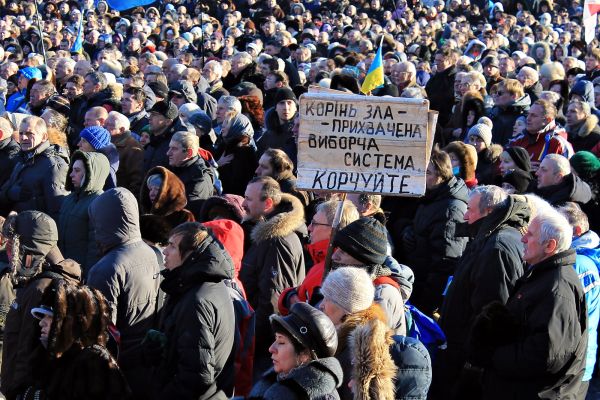The Need for a Leftist Appreciation of the EuroMaidan
While many leftists have rejected the EuroMaidan as a vehicle of Ukrainian nationalism, the protests actually have less to do with chauvinism and more with leftist ideals of social equality and an outrage against the government’s abuses.
February 3, 2014 -
Gela Merabishvili
-
Articles and Commentary

Photo: Wojciech Koźmic
Because Svoboda, Pravyi Sektor and Bandera’s black-and-red flags dominate the EuroMaidan, the left has so far been reluctant to endorse this movement. The left views the EuroMaidan as a right-wing movement and a vehicle for nationalistic forces which have nothing to do with European values. While there is logic and a grain of truth in this, this type of leftist understanding of the EuroMaidan is simplistic and one-dimensional. It underestimates the genuine leftist nature of the EuroMaidan.
In the end of November when the EuroMaidan emerged, western Ukrainian nationalism was perhaps the most important factor in shaping the wave of protests and it looked as if this movement would split Ukraine into two halves. Focusing on the east-west division of Ukraine, Max Fisher of the Washington Post has been publishing different versions of Ukrainian maps since the start of the EuroMaidan. These maps show linguistic, ethnic and electoral divisions that are compared with the main hotspots of the EuroMaidan: those western and northern regions of Ukraine that speak predominantly Ukrainian and voted against Yanukovich in the last two presidential elections were the ones where the protests took place. Naturally, eastern and southern Ukraine, populated mostly by Russians or Russian-speaking Ukrainians, did not share the revolutionary zeal of the EuroMaidan. While these maps made sense at the beginning of the EuroMaidan movement, day by day they seem more and more outdated.
In the beginning, the EuroMaidan was really about European choices and geopolitics. Therefore, it is right to assert that the western Ukrainian nationalists, due to their Russophobia, started these pro-European demonstrations because they see Europe as a way to get rid of Russian domination. It is also natural that the east and the south of the country did not show much interest in it. However, during the last two months or so, not the name of the EuroMaidan, but its content, pathos and goals have changed. Recently, the wave of protests has moved to the east of Kyiv and today most of the pro-Russian cities of eastern Ukraine have seen their people joining the EuroMaidan. These eastern Ukrainians protest not against the potential membership of Ukraine in the Eurasian Union, but against the unjust system created by the current government’s corruption and cynicism.
A change of this system is what the protesters are striving for today. Therefore, the EuroMaidan has become a weapon to fight against this system and has lost the geopolitical connotation which it initially had. Unlimited cynicism, the power and wealth of Yanukovych’s family and his close friends are equally unacceptable for any Ukrainian in Lviv or in Kharkiv. If geopolitics and Russophobia add additional incentives to the EuroMaidan in Lviv, in Kharkiv people are protesting because their sense of honour and civil liberties were neglected by Yanukovych’s government. None of the Eastern Ukrainian Russian speakers voted for Yanukovych in 2010 to help President’s son Oleskandr Yanukovych become one of the wealthiest people in the country.
So the initial view that the EuroMaidan would split Ukraine into two parts based on ethnic and linguistic lines has failed. Instead, this movement has united Ukraine’s east and west by providing them with a common opponent (the current system) and common objectives (a change of the system). The EuroMaidan, which was born out of the West vs. Russia narrative, transformed over time into an Occupy-style movement in which masses of ordinary people (the symbolic “99 per cent”) have turned against the rich and powerful governing clan (the “1 per cent”) to change the system.
This sort of understanding demonstrates that left-wing ideals of liberty, equality and fraternity, not right-wing nationalism or geopolitical preferences, are the leading factors behind the EuroMaidan protests. A declaration to join the EuroMaidan by the fans of Dynamo Kyiv clearly demonstrates the validity of such an understanding: “We appeal to all those who have yet to join the defence of Kyiv from these bastard sell-outs. We’re heading out not so we get brought into Europe, not for Yulia, Vitalik, Arseniy or Oleh, not against Russia and the Russians! We’re heading out for Kyivans, for our city, for our country and for our honour!”
Gela Merabishvili works at the Tbilisi State University as an editor of the e-library. He studied at the Tbilisi State University and Maastricht University.

































